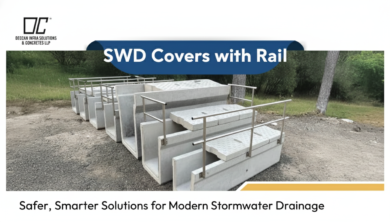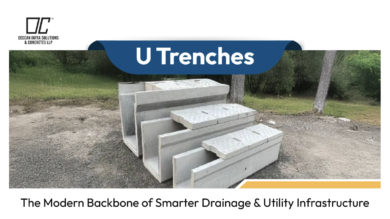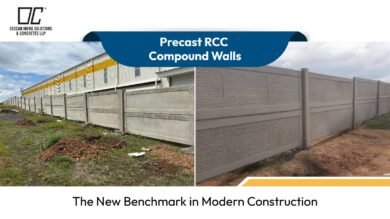Introduction
RCC (Reinforced Cement Concrete) U-Trenches are essential for efficient drainage and cable management in urban and industrial projects. Their robust construction, durability, and load-bearing capacity make them a preferred choice for infrastructure development. This blog covers the product details, installation process, precautions, and methods to install U-trenches in sloped areas.
1) Product Details
What is an RCC U-Trench?
An RCC U-Trench is a precast concrete channel designed for drainage and cable routing. It provides structural stability, longevity, and resistance to environmental factors like water, chemicals, and temperature fluctuations.
Key Features:
✔ High Strength & Durability – Reinforced with steel for enhanced load-bearing capacity.
✔ Precast Design – Ensures quick installation and uniform quality.
✔ Water & Chemical Resistance – Ideal for harsh environmental conditions.
✔ Easy Maintenance – Open-top design allows easy inspection and cleaning.
✔ Customizable Sizes – Available in different dimensions to suit project requirements.
Common Applications:
✅ Stormwater & drainage systems
✅ Industrial cable management
✅ Roadside and highway drainage
✅ Railway and metro projects
✅ Factory and warehouse infrastructure
2) Installation Process (Step-by-Step)
1️⃣ Site Preparation:
- Mark the trench path as per the layout.
- Excavate the area according to the required depth and width.
2️⃣ Base Preparation:
- Create a compacted sub-base using sand or crushed stone.
- Level the base and ensure proper grading for water flow.
3️⃣ Placement of RCC U-Trenches:
- Carefully place the precast U-trenches using a crane or mechanical lifting equipment.
- Align the sections properly to maintain uniformity.
4️⃣ Joint Sealing:
- Apply cementitious or rubber sealants at the joints to prevent leakage.
5️⃣ Backfilling & Compaction:
- Once the U-trenches are placed, backfill the surrounding area with compacted soil or concrete.
- Ensure proper compaction to avoid future settlement issues.
6️⃣ Final Inspection:
- Check for alignment, slope, and any gaps.
- Perform a water flow test to ensure efficient drainage.
3) Precautions During Installation
✔ Use Proper Lifting Equipment – RCC U-trenches are heavy; ensure proper lifting mechanisms to avoid damage.
✔ Ensure Proper Bedding – A well-compacted sub-base is crucial for long-term stability.
✔ Maintain Alignment & Joint Sealing – Misalignment can cause water leakage and structural issues.
✔ Avoid Heavy Loads During Installation – Prevent unnecessary pressure on freshly installed trenches.
✔ Follow Safety Protocols – Workers should wear safety gear and follow site regulations.
4) Installation on Sloped Areas & Slope Maintenance
Installing U-trenches on sloped terrain requires careful planning to ensure proper drainage flow and structural integrity.
How to Install on a Slope?
✅ Step Grading: Instead of a continuous slope, install trenches in stepped sections to control water velocity.
✅ Anchoring System: Secure trenches using reinforced concrete supports or anchoring rods to prevent movement.
✅ Adjusting Slope Inside the Trench: If the ground is level, create an internal slope by adjusting the trench bedding.
✅ Flow Control Mechanism: Install flow regulators or sediment traps to slow down water speed in steep areas.
Slope Maintenance Tips
✔ Regular Inspection – Ensure no blockages or sediment buildup.
✔ Reinforce the Base – Use geotextiles or concrete bedding to prevent erosion.
✔ Check for Erosion – Implement side retaining walls if necessary.
Conclusion
RCC U-Trenches offer an efficient, durable, and long-lasting solution for drainage and cable routing. Proper installation and maintenance are key to their performance, especially in sloped areas. By following the best practices outlined above, you can ensure smooth water flow, minimal maintenance, and long-term durability of your RCC trench system.





